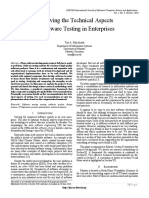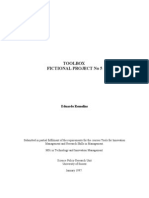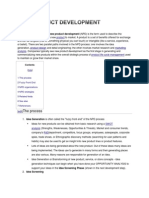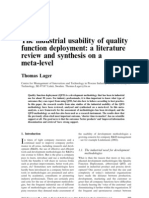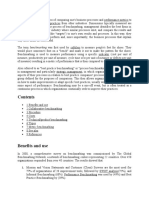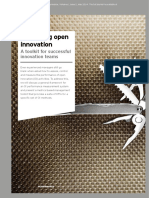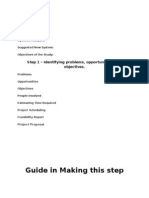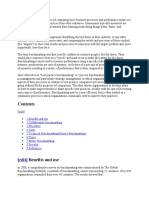Toolbox Fictional Project No 5: Eduardo Remolins
Toolbox Fictional Project No 5: Eduardo Remolins
Uploaded by
Eduardo RemolinsCopyright:
Available Formats
Toolbox Fictional Project No 5: Eduardo Remolins
Toolbox Fictional Project No 5: Eduardo Remolins
Uploaded by
Eduardo RemolinsOriginal Title
Copyright
Available Formats
Share this document
Did you find this document useful?
Is this content inappropriate?
Copyright:
Available Formats
Toolbox Fictional Project No 5: Eduardo Remolins
Toolbox Fictional Project No 5: Eduardo Remolins
Uploaded by
Eduardo RemolinsCopyright:
Available Formats
TOOLBOX FICTIONAL PROJECT No 5
Eduardo Remolins
Submitted in partial fulfilment of the requirements for the courses Tools for Innovation Management and Research Skills in Management. MSc in Technology and Innovation Management. Science Policy Research Unit University of Sussex January 1997.
1- Introduction 2- The toolbox 3- Tools that were not described in the course 4- References
1- Introduction.
The client. A small software company wishing to improve its innovativeness. It recognises the need to understand innovation in a more systematic fashion. The company is looking for a general overview/audit of its innovative activities, and recommendations about how can these activities be improved. The project. A useful way to organise the work is to divide it into different stages. To this end the present project is seen as including two parts: the assessment or audit and the process of facilitating the improve in companys current practices and performance. In relation to the first part the most suitable tool for assessment is Benchmarking, internal at the beginning (involving a self-assessment), and external in a second stage, involving comparisons with both companies in the same sector and companies in different sectors but performing similar processes. Regarding the second, and longer, part of the project, the starting point are the common factors found in a considerable number of successful innovations and frequently absent in failures1. They are: market orientation relationship to corporate objectives evaluation techniques good project management creativity innovative environment project champion
Having identified this common points, the aim is to search for tools to help in the developing of at least some of this features inside the company. There are not immediate solutions or recipes, but a conceptual framework together with some applied tools are a good mean to start the construction of the particular solution needed for every organisation.
1
Twiss (1993)
Ten tools have been selected (one for assessment and nine to help improve the innovation process), taking into account the characteristics of the client, namely a company of reduced size dedicated to the software industry. A company like that probably enjoys the advantage of having an organic form of organisation (dynamic, flexible, capable to learn, etc.). If this is the case the objective must be to improve the formal process of innovation but reinforcing this organic characteristics as long as they are the best asset a company could have in a rapidly changing environment, like software sector. If this is not the case, that is, the company is small but organised in a mechanistic form and therefore, suffering from many of the problems large firms have to perform innovation activities, the objective must be to change processes and procedures trying to reshape the organisation to allow the innovation process be more efficient. In what follows, the first possibility is assumed (the company is an organic one and wants to formalise more the innovation process in a way that will not inhibit its natural organisational advantage). One tool related with the corporate strategy has been chosen (technology portfolio analysis), two related with the evaluation of a new technology project (checklist and merit number system), and six related generally with creativity, but also with problem-solving across all sectors of the company (attribute analysis, morphological analysis, needs research, brainstorming, synectics, lateral thinking). The bias towards creativity-helping tools is motivated in the belief that this is the best way to reinforce the strengths of the company for this special sector. In effect, developing new particular solutions for customers arising from a general purpose technology (like IT), needs both closeness to the needs of the market (and that in time means listen to customers) and creativity and non-conventional ways of thinking to discover different possibilities of application of the core technologies of the company 2. Therefore, the tools selected are: 1- Benchmarking 2- Technology portfolio analysis 3- Checklist 4- Merit number system 5- Attribute analysis 6- Morphological analysis 7- Needs research 8- Brainstorming 9- Synectics
The same issue is described in the essay for the courses Inside Innovating Organisation and Technology, Firms and Innovating Systems, regarding the case of an IT company .
2
10- Lateral thinking
2- The toolbox.3
Tool 1: Benchmarking What is benchmarking? Basically is the search for industry best practices that leads to superior performance. Conventional means of performance improvement focus on measurement of performance levels and assessment of competitive strategies. The distinctive feature of benchmarking is that it focuses on business and management processes. If we understand innovation as a business process, benchmarking is a particularly suitable tool. Measures are important but the emphasis is on improving performance through understanding of process and practice. There are three essential pre-requisites of benchmarking, a framework to describe the processes to be compared, a focus on processes, and self assessment. The most successful frameworks, such as the US Baldridge Quality Award have proven to be effective both for self assessment and external benchmarking. The followings are the basic steps involved in benchmarking: 1- Choose the processes to be assessed/benchmarked 2- Review practices and performances of your own firm 3- Compare with one or more of: -a generic framework reflecting good practice -practices within other part of your own firm -practice of other firms 4- Identify the gaps between this and your performance 5- Identify reasons for the gaps 6- Institute actions to meet or exceed best in class practice Why benchmarking? It was said that in this case benchmarking would be used as a mean of self-assessment. Internal benchmarking (comparison of current practices and performance against the criteria set out in the innovation framework) is a prerequisite for external benchmarking (against other organisations) and is precisely a way of self assessment. A tailor-made benchmarking for innovation could include topics as: Leadership Product innovation Process innovation Technology acquisition Resourcing Systems and tools
3
Definitions and examples were taken from Twiss (1993) and London Business School (1992).
Benchmarking is also an ideal way to position the company and develop a strategy for it, including a technology strategy. Tool 2. Technology portfolio analysis. What is Technology portfolio analysis? The technology base of a company can be categorised as follows: 1-Core technologies 2- Complementary technologies 3- Peripheral technologies 4- Emerging technologies Corporate thinking is dominated by the core technology. It is central to all or most of the companys products. The expertise in this technology was the main contributor in the past success. A complementary technology is an additional technology, knowledge of which is essential in product design. A peripheral technology is defined as one not necessarily incorporated in the product but the application of which contributes to the effectiveness of the business. An example of this is the application of IT in managerial systems. Emerging technologies are new for the company, but may have a long-term significance. The developing of a core competence or the need for exploratory research may justify it. The latter (exploratory research) provides the company strategic flexibility to take advantage of arising opportunities. It is not of immediate importance in product development. The technology portfolio analysis directs attention to the needs of the future. This must be combined with an evaluation of the competence of the organisation to exploit those needs. A systematic approach could be applied, using a programmes/competencies matrix in order to construct an inventory of expertise which could improve the efficiency of R&D resource usage, identify the laboratorys strengths and weaknesses, assist individuals to identify and evaluate their own expertise, etc. Table 1. Technology portfolio analysis.
Relative importance Technology High Core A B C Complementary D X X X X X Current Medium Low High X X X Future Medium Low
7 E F Peripheral G H Emerging J K X X X X X X X X X X X X
Why technology portfolio analysis? The information provided by this tool is a prerequisite for the design of a technology strategy. The formulation of this strategy requires the scanning of the environment (economic, technological, etc.) to identify the opportunities and threats the company must face. Nonetheless, the election of optimal strategy that allows the exploitation of such opportunities and the overcoming of the threats, involves the consideration of what might be possible (the companys capabilities). Tool 3. Checklist What is a checklist? Is an evaluation technique commonly used for new products and technologies. It includes all the criteria which need to be taken into account when evaluating a project. This ensures that none is disregarded even though it may be difficult to evaluate many of them when the project is initially selected. Research studies show that checklists are widely used but is surprising how few companies attempt to compile a comprehensive list as a basis for formal evaluation. Twiss (1993) shows an example of checklist, reasonably suitable for most companies, involving the following aspects: A. Corporate objectives, strategy, policies, and values B. Marketing criteria C. Research and development criteria D. Financial criteria E. Production criteria F. Environmental and ecological criteria However, another example of list (this time to evaluate the feasibility of a new product), from an independent consultant 4, is simpler (and therefore more suitable for a small company) and is presented below. 1. 2. 3. 4. 5. 6. 7. 8.
4
What are the main features of the technology? Who is going to use the technology? What, if anything do they use now? What benefits or advantages will they get from using the new technology? Can this product be made? (or a service delivered?) How is the potential market segmented? How much can we afford to spend in its development? What are the main technical targets needed to make the product meet user requirements?
Kevin Parker. Seminar at Research Skills for Management course.
9. Will the beneficiaries of the technology be the ones who we ask to pay for it? 10. Does the technology give us any spin-off developments? 11. Are there any things which could stop the project? Tool 4. Merit number System. What is merit number system? A common development of the checklist is the project profile where each of the criteria is evaluated against a standard of performance. In completing the profile a judgement must be exercised for each item based upon quantitative analysis where possible and compared with a formal or informal understanding of what constitutes very good, good, etc. A further development is to device a merit number system, in which the individual items are given a weighting in accordance with their importance and each evaluation grade is also given a value. The calculation results in a merit number which gives an indication of the value of the project. Merit number system is just a sophistication of the simple checklist and must be understood as a substitute when circumstances make it desirable.
Creative problem-solving techniques. In what follows creative problem-solving techniques are described. These techniques can be divided into analytical (attribute analysis, morphological analysis, needs research), and nonanalytical (brainstorming, synectics, lateral thinking). The first ones are designed to reveal new approaches to problems or new combinations through systematic search. The second ones are a response to the belief that the innovation process (even formal R&D) is a creative one, which could be managed but not controlled rigidly. These techniques aim to develop the conditions characteristic of the creative process, whithin an experimental situation. Why creative problem-solving techniques? Having a technology strategy, one of the most important things for a company is the ability to mobilise the creativeness of its employees and apply this creativity into day-to-day problem-solving. The ultimate objective is to create what has been called the learning organisation. The powerful resource of people devoted continuously to improve processes and creatively develop new products or thinking about new uses of existing products and technologies, is one of the main sources (if not the most important) of competitive advantage. Unfortunately, as it was said, there are no recipes, and the process of upgrade in-company creativeness is not a well structured one. That is why six creativeness improving techniques (three analytical and three non-analytical) are proposed as a mean to begin enhancing the use of this powerful resource: peoples ideas. These problem-solving techniques are specially useful when applied in a receptive environment (open-minded and innovation-friendly), in which top management commitment has a lot to do. They are also an excellent complement to widely used team work approach to most innovation activities.
Tool 5. Attribute analysis. What is attribute analysis? Is the technique for analysing the attributes of a technology to show how they could be analysed in relation to their suitability in respect of a variety of practical applications. Some of these applications are not immediately apparent. Listing the technological attributes does, however concentrate the mind on the essentials of the phenomenon, thereby increasing the probability that the imagination will conceive an idea for a practical use. A similar approach has been developed for analysing the attributes of a product. An existing product is analysed in detail relating each part to the purpose it serves. The individual part can then be examined to determine whether it can be improved or used in a different combination to create a new product. The following questions which should be considered during the analysis, have been suggested- Put to other uses? Adapt? Modify? Reduce? Substitute? Rearrange? Reverse? or Combine? Tool 6. Morphological analysis. What is morphological analysis? A technique that involves the identification of the main parameters or functions of a problem, together with the various ways of achieving each of them. Every combination represents a possible solution. An example is shown below. In this problem there are three functions A, B, C; A can be satisfied in three ways, B in two ways, and C in four ways. Function A B C Alternatives A1 A2 A3 B1 B2 C1 C2 C3 C4
Total number of possible combinations ABC= 3x2x4= 24 In this case there are 24 different combinations which might satisfy the problem. In a practical example some of these combinations will already be known, some could be rejected as nonfeasible. but some might reveal new possibilities not previously thought of. Tool 7. Needs research. What is needs research? Is the analysis of complex technological systems incorporating a large part of technological subsystems. The most common result is the improvement of subsystem performance and not the replacement of the total system. It is vital in a problem of this nature that R&D investment is devoted to that part of the total system where it will bring the ultimate user the maximum benefit. Needs research is a modelling technique which enables a thorough investigation of the total system performance, in relation to forecasted user needs. The important features to note in needs research are:
10
1- The analysis starts with the users needs. 2- The use of technology forecasting to forecast these needs at some future period. 3- The employment of a modelling technique to relate subsystem and system performance to those needs. 4- The experimental determination of where investment can yield the best results before a project is defined. The architecture of most software programmes (a system of sub programs, each performing different functions), makes this tool (at a first sight), an extremely useful one for a software company. The improvement of the system (the application program, for example), through subsystems modifications without changing the whole, is the way many software companies upgrade its products. Successive versions of the same product allows them to cope with new users needs. Tool 8. Brainstorming. What is Brainstorming? Is a completely unstructured approach to group problem-solving. A group of people gathered together interact to generate ideas spontaneously. No evaluation is permitted during the brainstorming session and, although no attempt is made to relate the ideas, they owe a great deal to mutual stimulation and cross-fertilisation. The proceedings are recorded for subsequent detailed examination. The most common application of the technique has been to generate ideas for new products, and the creation of advertising slogans. Tool 9. Synectics. What is Synectics? Is a structured group technique W. Gordon(1961) devised for achieving a creative problem-solving climate. It aims to achieve: freedom from constraints imposed by the problem as stated, elimination of negative responses, deferred judgement, and escape from the boundaries imposed by orthodox thought patterns. The problem-solving process, sometimes called an excursion, consists of the following main stages: 1- A statement of the problem as given. 2- Analysis of the problem. 3- Immediate suggestions or purge 4- Statement of the problem as understood. 5- Increasing the metaphorical distance by means of: (a) direct analogy, (b) personal analogy, (c) compressed conflict. 6- Possible repetition of 5 in a different context.
11
7- Fantasy force fit. 8- Generation of possible solutions, or viewpoint. The inadequacies of an extremely brief written description of a technique, both emotional and experimental, are obvious. For an explanation of a greater length see Gordon (1961). Tool 10. Lateral thinking. What is lateral thinking? Is a technique developed by Edward de Bono that recognise the same underlying principles of creativity of Synectics. The term lateral thinking, describes the characteristics of creative imaginative, thought which distinguish it from the normal logical thought process, he calls vertical thinking. Before searching for new ideas it is useful to examine current ideas and identify the major influences giving shape to them. The things to look for include: dominant ideas which unduly influence and constrain the examination of a problem; tethering factors which are included without re-evaluation in every solution to a problem; polarising tendencies which make it difficult to assume a position between two extremes; acceptance of boundaries which unnecessarily restrict the area of investigation through preconceptions of where the solution of the problem ought to lie; and assumptions. Examination of the influences constraining the formation of current ideas leads to the development of a methodology to avoid them. Amongst the techniques he suggest are: questioning- asking why?; the rotation of attention between different aspects of a problem; the forced generation of a quota of alternative solutions; changing the concept; dividing and subdividing the parts of a concept or conversely, bridging the divisions between the parts in a new way. The most interesting techniques relate to the introduction of discontinuity into problem-solving in order to break the established pattern. This can often be achieved by the chance introduction of what at first sight may appear irrelevant. Thus exposure to irrelevancy can be of great value as a stimulant.
3- Tools that were not described in the course.
Tools that help to capture customers preferences and needs and to improve the effectiveness of design would have been suitable for this case. Examples of these tools include: Quality Function Deployment, Product and process Failure Mode and Effect Analysis, etc. Another set of tools, the ones commonly used in continuous improvement programmes, could have been of much use. Some examples are -as described in Bessant, (1994)- Pareto analysis and cause-effects diagrams. Some more complex statistical tools for the same purpose are also mentioned in the same work.
12
4- References.
De Bono, E. Lateral thinking for management, Mc Graw Hill, 1971. Gordon, W. J. J. Synectics, Harper & Row, 1961. London Business School, Innovation. Self assesment and benchmarking, Draft, July 1992. Twiss, B. Managing technological innovation, Pitman Publishing, 1993. Bessant, J., Caffyn, S., Gilbert, J., Harding, R. and Webb, S. Rediscovering continuous improvement, Technovation (1994) Vol 14 No 1 pp 17-29.
You might also like
- Case Study Tiger BrandDocument2 pagesCase Study Tiger Brandreza cellia50% (2)
- BBDT 2163 Tutorial 7Document4 pagesBBDT 2163 Tutorial 7CHIA MIN LIEWNo ratings yet
- Managing New Product and Process Development: Text CasesFrom EverandManaging New Product and Process Development: Text CasesRating: 3 out of 5 stars3/5 (1)
- C.6 Labeling and Fair PackagingDocument28 pagesC.6 Labeling and Fair PackagingDanzen Bueno ImusNo ratings yet
- Gillette - SWOT AnalysisDocument7 pagesGillette - SWOT AnalysisM HarikrishnanNo ratings yet
- Body Innovation WR FinalDocument23 pagesBody Innovation WR FinalJeneza LlanteNo ratings yet
- Innovation ManagementDocument33 pagesInnovation ManagementNavi SinghNo ratings yet
- Software Research & DevelopmentDocument17 pagesSoftware Research & DevelopmentSadaf Maqsood QaziNo ratings yet
- Introduction To Technology EvaluationDocument4 pagesIntroduction To Technology EvaluationGuillermo Sandoval SepulvedaNo ratings yet
- Answers To End of Chapter Questions: 1. Explain The Difference Between An As-Is and A To-Be SystemDocument8 pagesAnswers To End of Chapter Questions: 1. Explain The Difference Between An As-Is and A To-Be SystemNurain AliNo ratings yet
- What Is Management by Objectives?Document2 pagesWhat Is Management by Objectives?Heba SamiNo ratings yet
- 15.351 Managing Innovation and Entrepreneurship: Mit OpencoursewareDocument4 pages15.351 Managing Innovation and Entrepreneurship: Mit OpencoursewareFaizan AhmadNo ratings yet
- Managing New ProductDocument4 pagesManaging New Productkoirala1988No ratings yet
- Benchmarking - A Valid Strategy For The Long Term?: Annales Universitatis Apulensis Series Oeconomica, 11 (2), 2009Document14 pagesBenchmarking - A Valid Strategy For The Long Term?: Annales Universitatis Apulensis Series Oeconomica, 11 (2), 2009Coolmaharana MaharanaNo ratings yet
- BSA NotesDocument4 pagesBSA Notesfranzalaan100% (1)
- Improving The Technical Aspects of Software Testing in EnterprisesDocument10 pagesImproving The Technical Aspects of Software Testing in Enterprisesgetasif535No ratings yet
- Toolbox Fictional Project No 5: Eduardo RemolinsDocument12 pagesToolbox Fictional Project No 5: Eduardo RemolinsJohn DouglasNo ratings yet
- Management Technology and InnovationDocument28 pagesManagement Technology and InnovationSabbir Ahmed SolaimanNo ratings yet
- Article On Benchmarking by Kenneth CrowDocument17 pagesArticle On Benchmarking by Kenneth Crowkary290790No ratings yet
- Mbaln 670 T01Document9 pagesMbaln 670 T01KateNo ratings yet
- Benchmarking: Navigation Search Improve This Article Talk PageDocument11 pagesBenchmarking: Navigation Search Improve This Article Talk PagePrasenjit SakyaNo ratings yet
- Unit II ModuleDocument5 pagesUnit II Modulefrancesdimplesabio06No ratings yet
- Chapter 3Document38 pagesChapter 3Puneet Goel0% (1)
- Benchmarking Definition and HistoryDocument7 pagesBenchmarking Definition and HistoryMichelle Mc IntyreNo ratings yet
- What Is Operation ResearchDocument4 pagesWhat Is Operation ResearchAqua VixienNo ratings yet
- Operational Management Assignment PDFDocument7 pagesOperational Management Assignment PDFYonas D. Ebren100% (1)
- MBIE 8273 - Enterprise Innovation - Week 6Document29 pagesMBIE 8273 - Enterprise Innovation - Week 6Li ZHANGNo ratings yet
- Operational CreativityDocument11 pagesOperational CreativityMohammad Shafay ShahidNo ratings yet
- Unit 3 - Mi&eDocument9 pagesUnit 3 - Mi&eakshay thakurNo ratings yet
- Product ManagmentDocument27 pagesProduct Managmentmarie joy dagamiNo ratings yet
- Software and Design Assignment 4Document5 pagesSoftware and Design Assignment 4Lunara NurgalievaNo ratings yet
- Systems Analysis and Design: Lecturer: Albert OseiDocument107 pagesSystems Analysis and Design: Lecturer: Albert Oseitoa2bNo ratings yet
- MS 05Document8 pagesMS 05Rajni KumariNo ratings yet
- Thesis in Operations ManagementDocument6 pagesThesis in Operations ManagementTracy Morgan100% (2)
- Operations Management Lecture - 2Document6 pagesOperations Management Lecture - 2tusharNo ratings yet
- The Process: Business Engineering ProductDocument7 pagesThe Process: Business Engineering ProductAmiya MahatoNo ratings yet
- Assignment 1 - Paper - Literature Review - Operations ManagementDocument19 pagesAssignment 1 - Paper - Literature Review - Operations ManagementNidhiNo ratings yet
- Extra 4Document18 pagesExtra 4Diego Sanches FernandesNo ratings yet
- Product DevelopmentDocument6 pagesProduct DevelopmentDeonald Barcena TamodraNo ratings yet
- Benchmarking Is The Process of Comparing One's Business Processes and Performance Metrics ToDocument9 pagesBenchmarking Is The Process of Comparing One's Business Processes and Performance Metrics ToatetejNo ratings yet
- Measuring Open Innovation: A Toolkit For Successful Innovation TeamsDocument12 pagesMeasuring Open Innovation: A Toolkit For Successful Innovation TeamsAndy Garcia PeñaNo ratings yet
- Strategic Technology Selection and Classification in Multimodel EnvironmentsDocument17 pagesStrategic Technology Selection and Classification in Multimodel Environmentssurya0311No ratings yet
- Module 1Document48 pagesModule 1chuksbooksNo ratings yet
- Step 1 - Identifying Problems, Opportunities, and ObjectivesDocument9 pagesStep 1 - Identifying Problems, Opportunities, and ObjectivesAshley Brian Morales0% (1)
- Towards A Capability Model For The Software Release Planning Process - Based On A Multiple Industrial Case StudyDocument16 pagesTowards A Capability Model For The Software Release Planning Process - Based On A Multiple Industrial Case StudyMarcoNo ratings yet
- Chapter SummariesDocument11 pagesChapter SummariesIsra' I. SweilehNo ratings yet
- Bench MarkingDocument2 pagesBench MarkingDavid SelvaNo ratings yet
- Entrepreneurship - Organizing The EnterpriseDocument23 pagesEntrepreneurship - Organizing The Enterpriselorrieann83No ratings yet
- Introducing The Open Group Architecture Framework (TOGAF), Part 3: Create An Enterprise Architecture With TOGAFDocument4 pagesIntroducing The Open Group Architecture Framework (TOGAF), Part 3: Create An Enterprise Architecture With TOGAFsavio77No ratings yet
- Day 2 Chapter 2Document50 pagesDay 2 Chapter 2Rakesh UpadhyayNo ratings yet
- New Product Development WikipediaDocument9 pagesNew Product Development WikipediaBreylin CastilloNo ratings yet
- 3 R's of SCDocument5 pages3 R's of SCatishdkNo ratings yet
- Feasibility StudyDocument27 pagesFeasibility Studymynardgadingan100% (2)
- Intern Report ArjunDocument25 pagesIntern Report Arjunwhitesmoker240No ratings yet
- Development Processes and OrganizationsDocument41 pagesDevelopment Processes and OrganizationsPuneet GoelNo ratings yet
- Business Process ReengineeringDocument34 pagesBusiness Process ReengineeringRohan SharmaNo ratings yet
- Benchmarking Benchmarking Is The Process of Comparing One's Business Processes andDocument11 pagesBenchmarking Benchmarking Is The Process of Comparing One's Business Processes andNithish PujariNo ratings yet
- Mtic NotesDocument50 pagesMtic NotesAnshita GargNo ratings yet
- 1 BenchmarkingDocument6 pages1 BenchmarkingTiwaan02No ratings yet
- Bench MarkingDocument3 pagesBench MarkingDeven YuvvrajNo ratings yet
- Tutorial 01 Questions With Possible SolutionsDocument3 pagesTutorial 01 Questions With Possible SolutionsChand DivneshNo ratings yet
- How to Audit your Intellectual Property (IP)From EverandHow to Audit your Intellectual Property (IP)Rating: 3 out of 5 stars3/5 (1)
- Strategic Management - THE AIR ASIA STORY & CORE COMPETENCIESDocument7 pagesStrategic Management - THE AIR ASIA STORY & CORE COMPETENCIESNoor Hairulnizam NasirNo ratings yet
- Solar Sour Grapes?: Rebuilding For The FutureDocument12 pagesSolar Sour Grapes?: Rebuilding For The FutureelauwitNo ratings yet
- DabbawalaDocument36 pagesDabbawalasaurabh698No ratings yet
- Bioamla Project (Final)Document27 pagesBioamla Project (Final)Osama Iftikhar33% (3)
- Economic Model of Consumer BehaviorDocument25 pagesEconomic Model of Consumer Behaviorsamirjswl100% (2)
- BUSINESS PLAN AssignementDocument21 pagesBUSINESS PLAN AssignementBenjamin EliasNo ratings yet
- Preparing A Business Plan/Project ReportDocument2 pagesPreparing A Business Plan/Project ReportSoni JigeshNo ratings yet
- Unilever's Acquisition of Ben and Jerry'sDocument7 pagesUnilever's Acquisition of Ben and Jerry'sLarry GilmoreNo ratings yet
- ĐỀ THI MÔN PUB SPEAK 2023 - GV - revised by TanDocument8 pagesĐỀ THI MÔN PUB SPEAK 2023 - GV - revised by TanTrần A NaNo ratings yet
- Vice President Human Resources in NYC NY Resume Amy CarpenterDocument2 pagesVice President Human Resources in NYC NY Resume Amy Carpenteramycarpenter1No ratings yet
- Global Bike IncDocument39 pagesGlobal Bike IncSameet DoshiNo ratings yet
- Exploring The Impact of Brand PlacementDocument14 pagesExploring The Impact of Brand Placementaniket mishraNo ratings yet
- Project Report: School of Business Oct 2012Document28 pagesProject Report: School of Business Oct 2012Prosenjit RoyNo ratings yet
- Revised Resume August 2016Document2 pagesRevised Resume August 2016api-326164851No ratings yet
- NO Nama Usia Desa Karangrejo Tanggal Swab Antigen Tanggal Swab PCRDocument6 pagesNO Nama Usia Desa Karangrejo Tanggal Swab Antigen Tanggal Swab PCRm yusuf badrul anamNo ratings yet
- Tutorial 2Document3 pagesTutorial 2taliNo ratings yet
- Review of LiteratureDocument4 pagesReview of LiteratureRohit Khuswaha0% (2)
- ABM 2 - Pathiasmenos - Chapter 1-EditedDocument12 pagesABM 2 - Pathiasmenos - Chapter 1-EditedDaniel MadarangNo ratings yet
- Radha Hemmige Resume PRDocument3 pagesRadha Hemmige Resume PRapi-265064612No ratings yet
- Material Requirements Planning & ERP PPT at BEC DOMSDocument44 pagesMaterial Requirements Planning & ERP PPT at BEC DOMSBabasab Patil (Karrisatte)No ratings yet
- Twin Pints Business PlanDocument26 pagesTwin Pints Business PlanACBNo ratings yet
- Budgeting For Planning and ControlDocument23 pagesBudgeting For Planning and ControlMuhammad AbrarNo ratings yet
- Study On Consumer Behaviour Vodafone Project Report 29Document27 pagesStudy On Consumer Behaviour Vodafone Project Report 29Mitesh GandhiNo ratings yet
- Presentation On Packaging, Labeling, Warranties and GuaranteesDocument12 pagesPresentation On Packaging, Labeling, Warranties and GuaranteesChandan Pahelwani100% (2)
- Cadbury Dairy Milk Kuch Meetha Ho JaeDocument3 pagesCadbury Dairy Milk Kuch Meetha Ho JaenrsiddiquiNo ratings yet
- E - Commerce in IndiaDocument40 pagesE - Commerce in IndiaAvishek PathakNo ratings yet
















